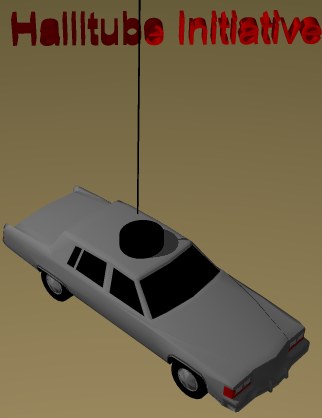Funding for Car-Stopping Techniques in Police Chases

Current procedures for car-stopping are inadequate: cars continue even if tires have been shot by moving on their rims at high speeds, and spike rails are often avoided by drivers by switching lanes or driving on the median. New research is in order. Removing the car with the magnet from above is really not feasible, as the helicopters for this are too costly. Other techniques need to be explored: For example, shooting a window-adhering black liquid as a ball from cartridges at the driver from in front of the car or from device lowered by coper.. Window obscuration by oils is one of the great hazards of single engine plane aviation, and requires immediate landing. The fleeing driver will be forced to drive with his head reaching out of the side window, very uncomfortable at high speeds. Other drivers are not placed at risk because they can simply stop at the roadside if the their window is hit accidentally by the liquid. Another technique is based on a standard helicopter lowering a magnet combined with a high-heat generating fuse and a tear gas tank on top of the car. The firmly seated device burns through a small section of the roof, the nozzle is inserted and the teargas is released. The concentration has to be sufficiently high so that even full opening of the window cannot counteract the eye and throat irritation from the first inhaled breaths. Such a small device (50 pounds) could also be oriented, and release a viscuous liquid from a tube extending onto the windshield.
Another approach is to make active police/driver cooperation part of the California license test. Given a hand signal, drivers at a level with a police car approach it from both sides, forming a three-car block. This block is too large to drive around and will stop the driver. The amateur participants merely have to learn to decelerate and speed up as dictated by the police car and stay closely by its side. Following the chase and arrest the participating cars are then photographed and damage is paid by the state. A special sound can also be emitted by the police car to alert nearby drivers to their obligation to participate in forming the car block. If the driver is known to be armed this technique would not be used.
The goal of these somewhat radical approaches is NOT the authoritarian objective of getting suspects at once into police custody: It is merely to shield hundreds and hundreds of drivers and their families from the disruptive delays caused by chases, and to insure that commerce can flow unimpeded.
The object dropped below forces its nozzles through the roof either by weight or drilling, and can releases 1) teargas, 2) windshield obscurer, 3) Marking paint making on-foot escape difficult. The drop is done just after the chase goes through an overpass, it should not take more than two minutes to aim and release the device with a small winch. Pilots get a swoop-map, which shows powerline/telephone lines crossing the highway, as well as overhanging traffic sign frequency. They know their local turf, and this should not prove an obstacle. The device sits tight on the hood as soon as it is dropped. Alternate secenarios are dropping a larger device filled with water on the front hood, with muliple seating nozzles, with the intention of flooding the engine by releasing water directly on it through the nozzles that have penetrated the hood., with an accompanying release of steam making driving difficult. News helicopters might be required to carry such devices, perhaps twice the size of fax machines.
Motorcycles and their riders can be "marked" if not stopped by having the helicopter move ahead of the motorcycle. It lowers are 3 gallon neon paint holder with a remote dispensing mechanism. No , the driver won't crash, because right have the paint has covered his helmet plexiglas shield, he flips it up, by this time the 2 second long paint stream has stopped. Again, news helicopters will be required to carry these under the referendum. This techniques prevents fleeing into malls, recently accomplished by an astute driver.
Again, this may all have an authoritarian flavor, and we advocate it only if the driver choses to flee on a highway or heavily travelled road, i.e. where the running creates victims.
